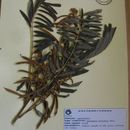Comprehensive Description
provided by North American Flora
Cracca toxicaria (Sw.) Kuntze, Rev. Gen. 175. 1891
Galcga toxicaria Sw. Prodr. 108. 1788. Tephrosia toxicaria Pers. Syn. PI. 2: 328. 1807. Tephrosia Schiedeana Schlecht. Linnaea 12: 299. 1838.
A shrub, 5-15 dm. high, woody below; branches thick, sulcate, densely reddishor yellowish-vclutinous; leaves 2-3 dm. long; stipules setaceous, 1 cm. long, caducous, velutinous; petiole 1-3 cm. long, as well as the lachis densely velutinous, sulcate on the upper side;
* Type specimen not seen, but a specimen in fruit collected by M. K. Jones in Cayanopa Caflon is doubtfully referred to C. Thurberi, having shorter and more appressed pubescence and smaller leaflets. leaflets 21-4 I, linear-oblong or linear, 47 cm. long, 8-18 mm. wide, obtuse or acutish, mucronate at the apex, short-silky above, densely long-silky beneath; racemes terminal and in the upper axils, 1-2 dm. long, dense, many-flowered; flowers 3-6 at each node; bracts subulatesetaceous, acuminate, caducous; calyx densely reddish-velutinous, the tube 2.5-3 mm. long, the lobes ovate, 3 mm. long, abruptly acute; corolla whitish or pale-yellow, 1.5-20 mm. long; banner orbicular, silky on the back, short-clawed; wings obliquely oblanceolate, with a rounded basal auricle; pod 5-7 cm. long, 5-6 mm. wide, densely ferruginousvillous, I0-15-seeded; seeds 4 mm. long, 2.5 mm. broad.
Type locality: West Indies.
Distribution: Jamaica; southern Mexico to Bolivia, Northern Brazil, and Guiana.
- bibliographic citation
- Per Axel Rydberg. 1919. (ROSALES); FABACEAE; PSORALEAE. North American flora. vol 24(1). New York Botanical Garden, New York, NY
Physical Description
provided by USDA PLANTS text
Perennial, Shrubs, Herbs, Stems woody below, or from woody crown or caudex, Taproot present, Nodules present, Ste ms erect or ascending, Stems less than 1 m tall, Stems 1-2 m tall, Stems greater than 2 m tall, Stems solid, Stems or young twigs sparsely to densely hairy, Stem hairs hispid to villous, Leaves alternate, Leaves petiolate, Stipules inconspicuous, absent, or caducous, Stipules setiform, subulate or acicular, Stipules persistent, Stipules free, Leaves compound, Leaves odd pinnate, Leaf or leaflet margins entire, Leaflets opposite, Leaflets 10-many, Leaves hairy on one or both surfaces, Inflorescences racemes, Inflorescence terminal, Inflorescence leaf-opposed, Bracts conspicuously present, Flowers zygomorphic, Calyx 5-lobed, Calyx hairy, Petals separate, Corolla papilionaceous, Petals clawed, Petals white, Petals red, Banner petal ovoid or obovate, Banner petal suborbicular, broadly rounded, Wing petals narrow, oblanceolate to oblong, Wing petals auriculate, Wing tips obtuse or rounded, Keel petals auriculate, spurred, or gibbous, Keel tips obtuse or rounded, not beaked, Stame ns 9-10, Stamens diadelphous, 9 united, 1 free, Filaments glabrous, Style terete, Style sharply bent, Style hairy, Style hairy on one side only, Fruit a legume, Fruit unilocular, Fruit freely dehiscent, Fruit elongate, straight, Fruit exserted from calyx, Valves twisting or coiling after dehiscence, Fruit beaked, Fruit hairy, Fruit 3-10 seeded, Seeds ovoid to rounded in outline, Seed surface smooth, Seeds olive, brown, or black, Seed surface mottled or patchy.

